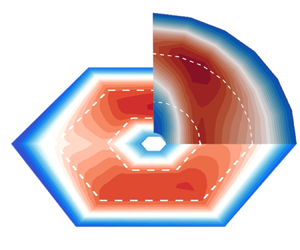Published online by Cambridge University Press: 27 October 2023

The third-order law links energy transfer rates in the inertial range of magneto- hydrodynamic (MHD) turbulence with third-order structure functions. Anisotropy, a typical property in the solar wind, challenges the applicability of the third-order law with the isotropic assumption. To shed light on the energy transfer process in the presence of anisotropy, we conducted direct numerical simulations of forced MHD turbulence with normal and hyper-viscosity under various strengths of the external magnetic field ( $B_0$), and calculated three forms of third-order structure function with or without averaging of the azimuthal or polar angles with respect to
$B_0$), and calculated three forms of third-order structure function with or without averaging of the azimuthal or polar angles with respect to  $B_0$ direction. Correspondingly, three estimated energy transfer rates were obtained. The result shows that the peak of normalized third-order structure function occurs at larger scales closer to the
$B_0$ direction. Correspondingly, three estimated energy transfer rates were obtained. The result shows that the peak of normalized third-order structure function occurs at larger scales closer to the  $B_0$ direction, and the maximum of longitudinal transfer rates shifts away from the
$B_0$ direction, and the maximum of longitudinal transfer rates shifts away from the  $B_0$ direction at larger
$B_0$ direction at larger  $B_0$. Compared with normal viscous cases, hyper-viscous cases can attain better separated inertial range, thus facilitating the estimation of the energy cascade rates. We find that the widespread use of the isotropic form of the third-order law in estimating the energy transfer rates is questionable in some cases, especially when the anisotropy arising from the mean magnetic field is inevitable. In contrast, the direction-averaged third-order structure function properly accounts for the effect of anisotropy and predicts the energy transfer rates and inertial range accurately, even at very high
$B_0$. Compared with normal viscous cases, hyper-viscous cases can attain better separated inertial range, thus facilitating the estimation of the energy cascade rates. We find that the widespread use of the isotropic form of the third-order law in estimating the energy transfer rates is questionable in some cases, especially when the anisotropy arising from the mean magnetic field is inevitable. In contrast, the direction-averaged third-order structure function properly accounts for the effect of anisotropy and predicts the energy transfer rates and inertial range accurately, even at very high  $B_0$. With limited statistics, the third-order structure function shows a stronger dependence on averaging of azimuthal angles than the time, especially for high
$B_0$. With limited statistics, the third-order structure function shows a stronger dependence on averaging of azimuthal angles than the time, especially for high  $B_0$ cases. These findings provide insights into the anisotropic effect on the estimation of energy transfer rates.
$B_0$ cases. These findings provide insights into the anisotropic effect on the estimation of energy transfer rates.